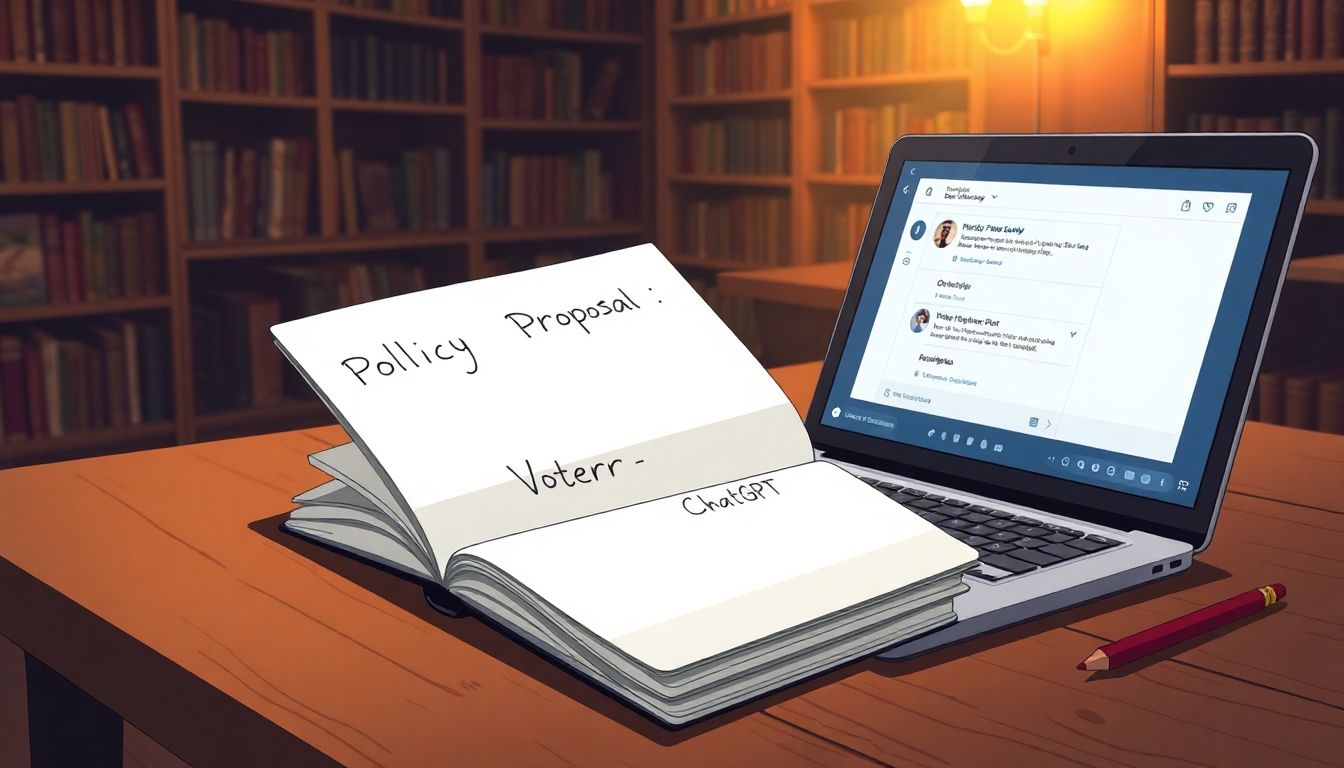Navigating the world of political strategy can feel like trying to solve a Rubik’s Cube blindfolded. You might find yourself overwhelmed by constant social media noise, shifting public opinions, and the pressure to stand out in a crowded field. It’s perfectly normal to feel that you’re missing out on the latest techniques to engage voters and outsmart opponents.
But what if I told you there’s a way to make this challenge a whole lot easier? By harnessing the power of ChatGPT, you can whip up effective strategies, catchy slogans, and tailored messages that resonate with your audience. Stick with me and I’ll show you how to turn ChatGPT into your sidekick in the political arena.
We’ll cover everything from identifying key issues to conducting opponent analyses and even crafting engaging social media content. Plus, we’ll share some inspiring case studies to illustrate how others have successfully leveraged this tool. Let’s dive in!
Key Takeaways
- ChatGPT can streamline political strategy by generating tailored ideas, such as voter engagement tactics and slogan suggestions.
- By asking specific questions, you can identify key voter concerns and emerging issues to focus your campaign on.
- Use ChatGPT to create catchy slogans that are relatable and appealing to different demographics.
- Analyze opponents’ strategies and weaknesses using targeted prompts, allowing you to find competitive advantages.
- Leverage ChatGPT for drafting compelling policy proposals and obtaining feedback for improvements.
- Create engaging social media content by generating post ideas, polls, and staying aligned with current trends.
- Utilize ChatGPT to develop effective voter outreach strategies with personalized messages for different voter segments.
- Simulate voter conversations and debates to prepare for real interactions and improve your communication skills.

How to Use ChatGPT for Developing Effective Political Strategies
Using ChatGPT can significantly enhance your political strategy development.
To begin, outline your campaign goals and target audience.
Then, prompt ChatGPT with specific questions or tasks to receive tailored responses.
For example, you might use the prompt: “List five key strategies for winning voters in a local election.”
This will help you generate innovative ideas and think outside the box.
Always remember to refine and adjust the responses based on your specific context.
Try using ChatGPT to brainstorm communication strategies by saying: “What messaging strategies resonate with young voters?”
Ultimately, leveraging AI can streamline your strategic planning and provide fresh insights for effective campaign planning.
Identifying Key Issues and Themes in Political Campaigns with ChatGPT
ChatGPT excels in analyzing voter concerns and identifying key political issues.
You can gather a wealth of insights by asking targeted questions.
For instance, use: “What are the top three concerns of voters in the upcoming election?”
This will help you prioritize campaign themes that resonate with your audience.
Additionally, consider prompting ChatGPT with: “Analyze the current political climate and identify emerging issues relevant to young voters.”
Through this, you can receive a clearer picture of the key themes to focus your campaign on.
Stay updated by asking about trending topics by saying: “Summarize recent political developments that could impact voter sentiment.”
Such prompts keep your campaign aligned with the pulse of public opinion and increase its relevance.
Generating Catchy Slogans and Messaging using ChatGPT
Creating catchy slogans is essential for effective branding in political campaigns.
Start by describing your campaign in a few sentences and prompt ChatGPT with: “Generate five catchy slogans for a campaign focused on education reform.”
Think about using language that is relatable and straightforward.
For example, you can refine your prompts by saying: “Draft three engaging taglines that emphasize community empowerment.”
ChatGPT can also help in tailoring messages to different audience demographics.
Try: “Create a message that speaks to environmental concerns for young voters.”
Finally, solicit feedback for your options by asking: “Evaluate these slogans for effectiveness and appeal.”
This iterative process helps you hone in on the most effective messaging.
Conducting Opponent Analysis with ChatGPT Prompts
Understanding your opponents is key to crafting a competitive political strategy.
ChatGPT can assist with this by generating insights based on their public communication.
Start by asking: “Analyze the strategies used by [Opponent’s Name] in their last campaign.”
This will provide you with a snapshot of their approach and areas to target.
You can further probe by saying: “List potential weaknesses in [Opponent’s Name]’s recent policy proposals.”
This helps you exploit gaps in their strategies.
Consider analyzing their social media presence with a prompt like: “Assess [Opponent’s Name]’s social media engagement and suggest counter-strategies.”
This way, you can identify opportunities to outperform your competition.
Integrate these analyses into your overall campaign strategy to maintain a competitive edge.

Drafting Policy Proposals and Position Statements with ChatGPT
ChatGPT can be an invaluable tool for drafting policy proposals and position statements.
Start by defining the core issues you want to address in your proposal.
Use a prompt like: “Outline a policy proposal for improving healthcare access in low-income communities.”
This can help structure your ideas and ensure you cover all important aspects.
Include specifics by asking ChatGPT to: “Suggest key components that should be included in a position statement on climate change.”
To make your proposals more impactful, encourage ChatGPT to include statistics or case studies.
Try using: “Provide statistics that support the need for education reform in urban areas.”
Finally, refine your drafts by prompting: “Critique this policy proposal and suggest improvements.”
This iterative process leads to clear and compelling policy documents that resonate with stakeholders.
Creating Engaging Social Media Content for Political Campaigns
Engaging social media content is a key part of connecting with voters.
Start by placing yourself in the shoes of your audience.
Use ChatGPT to generate ideas by asking: “Create five engaging posts for social media about my campaign’s stance on renewable energy.”
Consider different formats, like polls or questions, by prompting: “Draft a poll for Twitter asking which local issue voters care about most.”
Utilize visuals by asking: “Suggest image ideas for a campaign post advocating for affordable housing.”
To stay relevant, inquire about current trends with: “Identify popular hashtags related to education reform this month.”
Finally, schedule regular content prompts like: “Plan a week’s worth of social media content for my campaign.”
This approach keeps your messaging fresh and increases engagement across platforms.
Utilizing ChatGPT for Voter Outreach Strategies
Voter outreach is crucial for increasing engagement and turnout.
ChatGPT can help you create targeted outreach strategies effectively.
Begin by analyzing your audience; prompt with: “Describe the best methods to engage first-time voters in a local election.”
Following this, explore communication styles by asking: “Propose outreach messages tailored for younger voters.”
Incorporate direct dialogue by using: “Draft a script for a phone call outreach to swing voters.”
Evaluate which communication channels to focus on by prompting: “Compare the effectiveness of door-to-door canvassing versus digital outreach.”
Create a plan by saying: “Outline a six-week voter outreach campaign leading up to the election.”
Using these prompts can help create a comprehensive and responsive outreach strategy to connect voters with your campaign.
Simulating Voter Conversations and Debates with ChatGPT
Simulating voter conversations can sharpen your debate skills and prepare you for real interactions.
Use ChatGPT to create realistic audience scenarios by prompting: “Generate a dialogue between a candidate and a skeptical voter on healthcare policy.”
Identify common voter concerns by asking: “List typical objections raised by voters during town halls regarding tax reform.”
Practice rebuttals by using a prompt like: “How should I respond to voters who oppose my stance on immigration reform?”
Simulate a debate environment: “Run a mock debate between me and an opponent focusing on climate policies.”
This not only prepares you for confrontations but also builds your confidence.
Finally, ask for advice on improving your engagements with: “Suggest ways to make my responses more relatable to everyday voters.”
This form of preparation can lead to more effective communication and a stronger presence in debates and discussions.

Evaluating the Effectiveness of Political Strategies Using ChatGPT
Evaluating the effectiveness of your political strategies is crucial for continuous improvement.
ChatGPT can assist by analyzing data and providing insights into your campaign’s performance.
Start with performance metrics by asking: “What key performance indicators should I track for my campaign?”
Then, delve into specific strategies by using: “Assess the effectiveness of my social media outreach in engaging voters.”
Request a comparative analysis with: “Compare my current strategy with successful tactics from past campaigns.”
To identify areas for improvement, try: “List common pitfalls in political campaigns and how to avoid them.”
Finally, summarize findings with: “Provide recommendations for adjusting my campaign strategy based on recent data.”
This helps ensure your campaign adapts and remains effective as voter preferences change.
Case Studies: Successful Political Campaigns Leveraging ChatGPT
Studying successful political campaigns can provide valuable lessons on effective strategies.
ChatGPT can help identify and analyze these case studies.
Start by asking for examples: “List successful political campaigns that utilized AI tools like ChatGPT.”
Investigate the specifics by saying: “Summarize the key strategies used in [specific campaign] that led to its success.”
Explore the impact of these strategies by using: “Analyze how ChatGPT helped shape campaign messaging for [specific candidate].”
Learn from mistakes by prompting: “What lessons can be learned from failed political campaigns?”
Finally, ask for a synthesis: “Combine insights from multiple case studies into actionable strategies for my campaign.”
Using these prompts, you can gain a wealth of knowledge to inform your own campaign endeavors.
FAQs
ChatGPT can analyze public discourse, social media trends, and election data to identify pressing issues and themes that resonate with voters, helping campaign teams align their strategies with current priorities and sentiments.
ChatGPT can create catchy and memorable slogans by analyzing successful campaign phrases, utilizing creativity, and ensuring alignment with campaign themes, ensuring your messaging stands out to potential voters.
ChatGPT can generate prompts to analyze opponents’ strengths, weaknesses, and messaging strategies, providing insights that can help refine your own campaign approach and counter-strategies effectively.
ChatGPT can help design targeted outreach campaigns by crafting personalized messages, analyzing voter demographics, and suggesting efficient communication channels to increase engagement and turnout.
